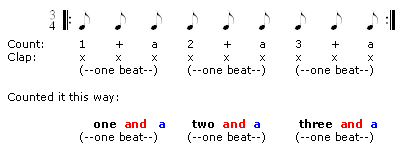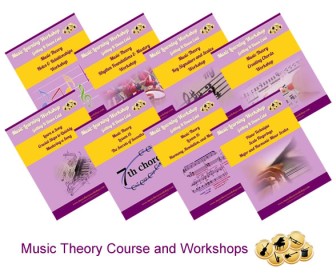Three Part Beats
Here we will move into dividing beats into three parts. We will call it a triplet rhythm pattern. We work with
-
Reviewing 3/4 time signature
-
Add new terms for counting the rhythm triplet pattern.
-
Easily seeing the different applications of using the triplet pattern.
So what happens when we use eighth notes on a quarter beat pattern but have 3 notes instead of two? Another great question. Let’s investigate this 3 part beat.
Review 3/4 Time Signature
Review the straight beats on the 3/4 time signature.

This is easily counted as 1 2 3, 1 2 3. But What if we wanted to divide the beats into 3 sub-parts as follows:

Once again we took the beat and made it three parts.
How would you know that three 8th notes would be counted this way? There are a couple of ways that this will show up.
Take a look:
One common way is to express 3 beamed ![]() with a 3 and bracket across the top indicating a triplet, like this.
with a 3 and bracket across the top indicating a triplet, like this. ![]() Or
Or ![]() for quarter notes.
for quarter notes.
They can be written with 3 beamed 8th notes like this
![]()
Here is an example of the x head: ![]() or
or ![]()
Explore further the counting with other notes. Once again it is very important to count all three pieces of the beat to keep the rhythm smooth and consistent.
Rhythm – More Practice with Triplets
Practice on these rhythms, be sure to count out load and start slowly:

Cross of the number ever time you complete five repeats (5x)
1 2 3 4 5 6 7
Here’s the basic swing rhythm. Accent the “a” as in we use the “>” to show the accent on a note.

Cross of the number ever time you complete five repeats (5x)
1 2 3 4 5 6 7
The key to sub dividing beats into triplets is to know that counting a triplet with the “and a” and to do it even when the other notes are longer.
Again this can be clearer once you apply this to an instrument. Audition these rhythm triplet patterns and apply counting rhythm rests using a piano or other instrument.
Play a single note where shown, count slowly and hold where indicated. Do it several times and you will be able to count the rhythm triplet pattern easily.

